Clematis Dr. Ruppel - the intricacies of growing tree liana
It is impossible not to pay attention to Dr. Ruppel's clematis. This large-flowered liana-like shrub with an original color of buds will become an undeniable decoration of the garden, attracting the eyes of neighbors. At the same time, the cultivation of a plant does not imply any particular difficulties; in order to maintain the decorativeness and health of the culture, it is enough to adhere to several of its requirements.
- Description of the variety
- Landing features
- Timing
- Seat selection
- Preparation of planting material
- Landing technology
- Care
- Watering
- Top dressing
- Loosening and mulching
- Pruning
- Shelter for the winter
- Reproduction
- Cuttings
- By dividing the bush
- Layers
- Diseases and pests
- Use in landscape design
- Reviews by the gardener
- Useful videos
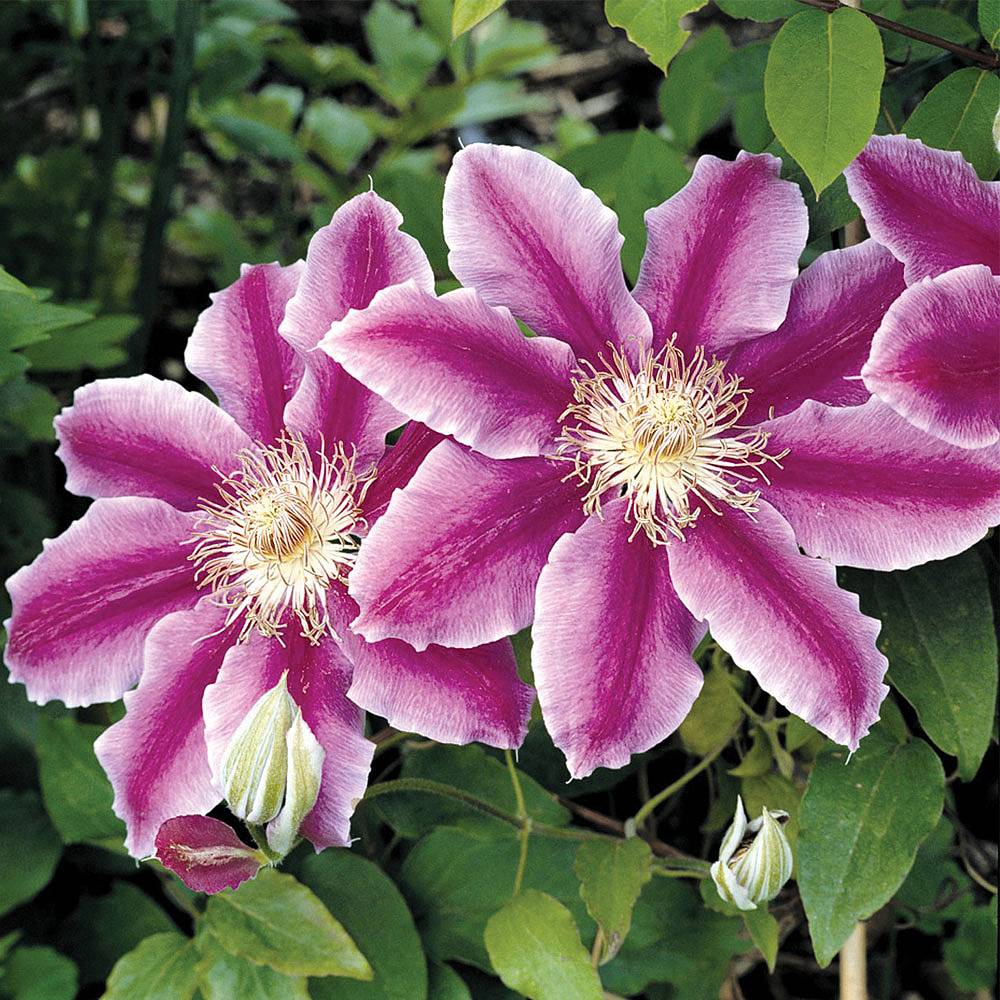
Clematis Dr. Ruppel Photos
Description of the variety
Clematis Doctor Ruppel (lat.Clematis Doctor Ruppel) is a hybrid variety bred by breeders in 1975 in Argentina. According to some historians, the discovery of the variety belongs to the scientist Jim Fisk from England.
The shrub is represented by a tree-like liana, the stems of which are capable of reaching 2.5-3 m. The tendrils are present on the vegetative processes, due to which the bush is attached to the support.
The flowers are large, up to 20 cm in diameter, star-shaped, pale pink in color with a purple tint. The petals are oval, elongated, with a sharp tip and a wavy outline. Presented in the amount of 6-8 pcs. In the middle there is a pronounced stripe of saturated raspberry or wine color. Anthers beige with white stamens.
The buds are formed on last year's shoots and shoots that appeared in the current season. The early ones have a paler color, the specimens of the second wave fully correspond to the characteristics of the variety.
The root system is powerful enough, in depth and in diameter it can reach 1 m.
Landing features
Timing
The variety is frost-resistant, withstands temperatures in winter from -7 to -29 ° C.
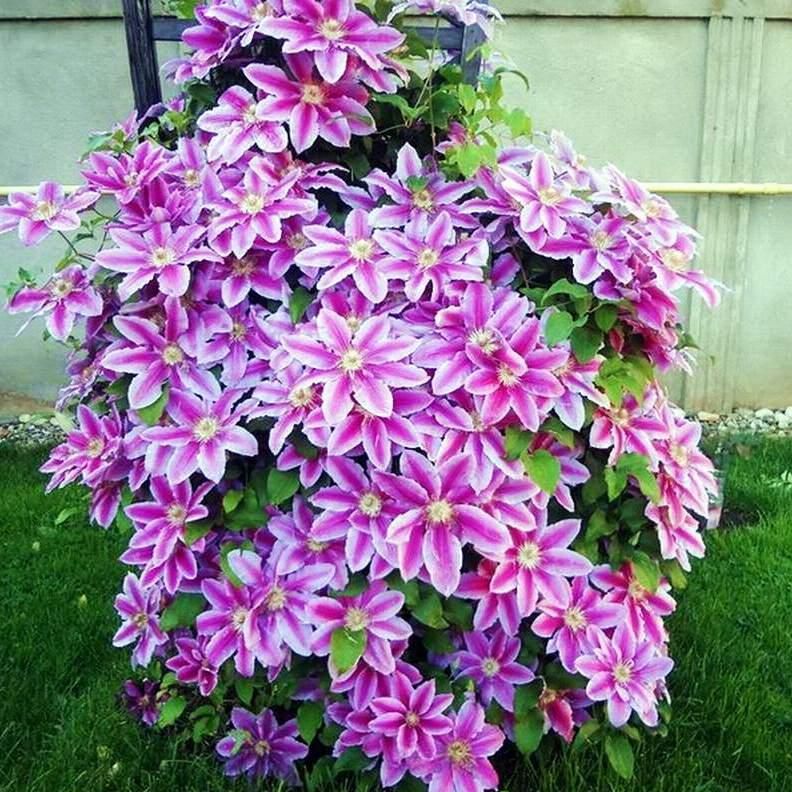
Dr. ruppel clematis description
The optimal time for planting seedlings with an open root system is autumn, a month before the cold weather. When buying copies in a container, they are moved to the substrate regardless of the season, they can be planted both in spring and in autumn, while maintaining an earthen lump.
Seat selection
The plant is light-loving, but constant exposure to direct sunlight leads to the burnout of the buds.
For planting, the southern, southeastern or southwestern sides are suitable, on which the crown receives the required amount of light, and the root system is shaded.
Places with regular stagnation of moisture should also be discarded. Liana feels more comfortable on well-drained, breathable soils with neutral acidity. If necessary, slaked lime or dolomite flour is added to the substrate to deoxidize it.
It is allowed to grow clematis near a fence or buildings, while retreating at least 0.5 m from the building. When placed next to a trellis or pergola, a similar distance recedes from the support.
Additionally, you should consider protection from drafts, especially young bushes are sensitive to sharp gusts of wind.
Preparation of planting material
When buying clematis with open roots, they must be examined for elasticity and the subject of mold. The optimal size of the root system is 25 cm.
Additionally, you should pay attention to the branches of a young shrub - they should be about 40 cm long with no damage of any kind on the bark.
After the acquisition, the rhizome is kept for 30 minutes in a solution of potassium permanganate, dipped in a clay chatterbox.
Plants in transport containers are placed in a bucket of water to moisten the substrate and reduce the risk of root injury during planting.
Landing technology
Step-by-step description of the process:
- They dig a spacious hole 0.6 * 0.6 * 0.6 m in size (for group planting, they maintain an interval of one meter, given the large dimensions of the culture). Lay out a drainage layer.
- Prepare the soil mixture. For this, 6 kg of sand and peat, 10 kg of vegetable humus, 200 g of wood ash, 70 g of superphosphate are added to the garden soil.
- Partially pour the prepared substrate in the form of a mound. Stick in the support.
- A seedling is installed by carefully straightening the roots along the hill.
- The remaining space is filled so that the root collar is deepened by 6-9 cm, which leads to more abundant shoot formation.
- Seal the surface, water abundantly, mulch.
Care
Watering
Clematis react painfully to stagnant moisture, so you should refrain from excessive watering, especially in cool and cloudy weather.
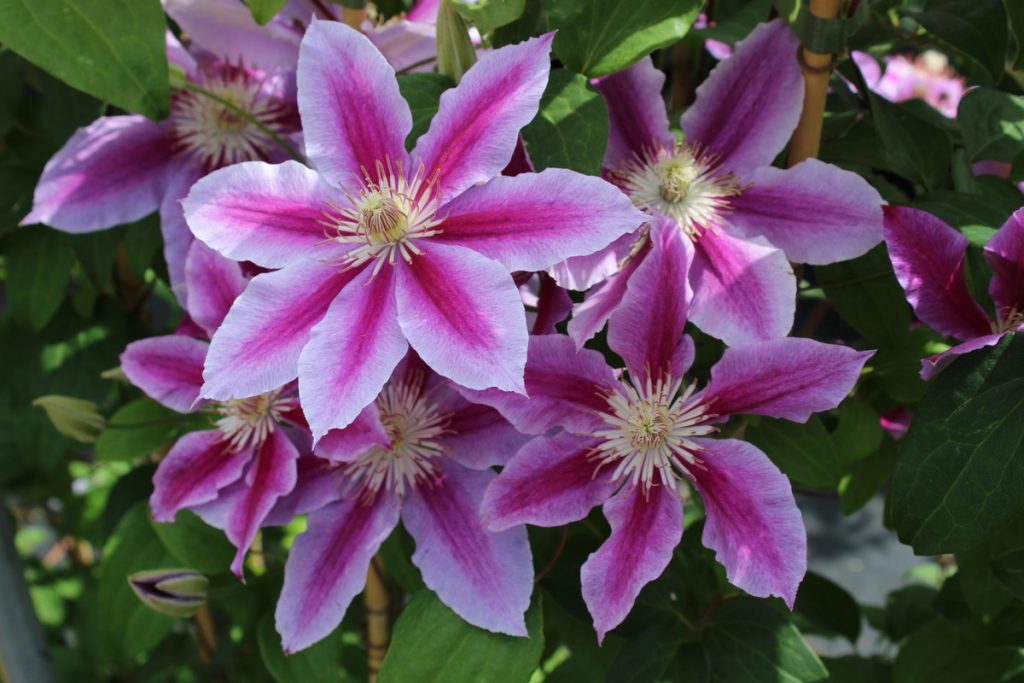
Description and photo of clematis doctor ruppel
In temperate climates, the shrub is watered once every 7 days, subject to a particularly dry summer - the time interval is reduced. Water for irrigation is used settled, pre-heated in the sun.
Consumption - 10-30 liters, depending on the size and age of the vine. At the same time, they try to avoid moisture getting on the green part of the plant. After the procedure, mulching is carried out.
Top dressing
The key to the productive cultivation of clematis is the regular introduction of nutrients due to the fact that the active growth of the crown of the culture leads to its depletion and a decrease in immunity.
The primary feeding is done in early May, when the beginning of the growing season and the formation of buds is observed, then the procedure is repeated every 7-10 days.
As drugs are used:
- Fertik Lux;
- Kemiru Lux;
- Effekton;
- Riga mix;
- Agricola.
Also, during this period, after pruning, the soil is spilled with a solution of ammonium nitrate (60 g per 10 liters of water) at the rate of: 5 liters for a young plant, 10 liters for an adult bush.
In the fall, they are fed with the following composition:
- water - 10 l;
- superphosphate - 20 g;
- potassium sulfate - 20 g.
Loosening and mulching
Regular loosening of the soil in the near-stem space will provide the necessary degree of aeration of the substrate. Additionally, during the procedure, weeds are eliminated that inhibit the growth of vines. Manipulations are carried out extremely carefully, not very deeply immersing the garden tool in the ground, so as not to damage the closely located roots.
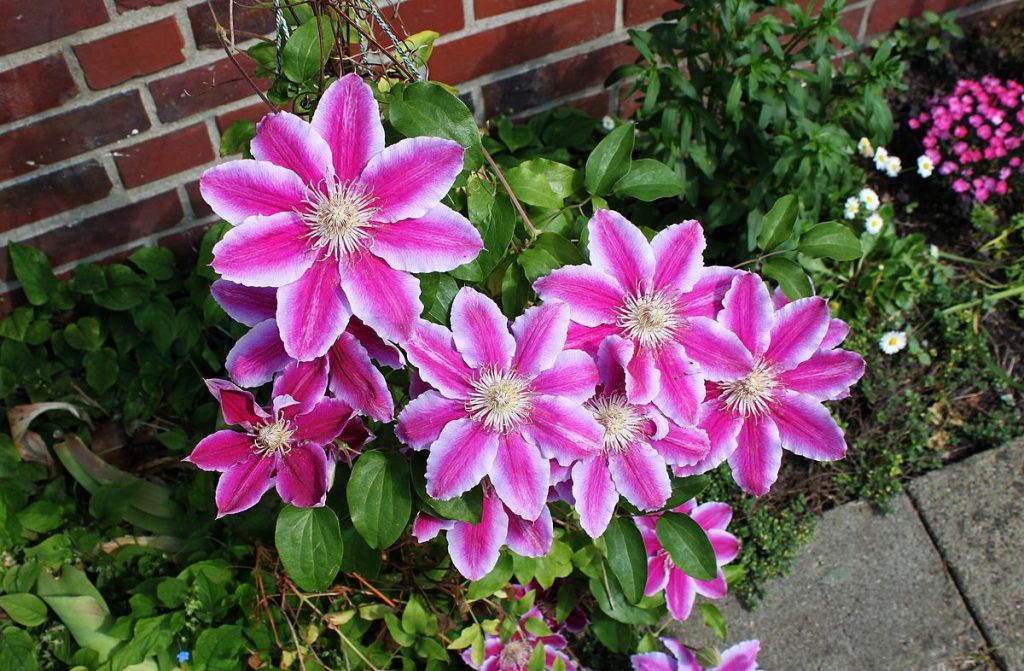
Clematis dock ruppel
Particular attention is paid to mulching; humus, hay, sawdust, peat are used as material. This approach allows you to prevent overheating of the underground part of the plant, its freezing in winter and excessive evaporation of moisture.
Pruning
This type of clematis belongs to the 2nd pruning group. The haircut is done moderately, shortening the shoots in autumn by ⅓ of the entire length. Additionally, the vegetative processes are normalized, stopping the weak and injured, while leaving about 12 healthy segments. In the first year after planting, young plants are completely pruned at the base.
In the spring, the branches are pruned by a couple of centimeters, while removing all those damaged during the winter.
Shelter for the winter
After pruning and removing from the support, Dr. Ruppel's adult vines are twisted and laid so that they do not come into contact with the ground.For this, slats or a thick layer of straw and plant residues are placed on the surface.
On top, the sprouts are covered with agrofibre or burlap, covered with spruce branches. Some gardeners install a fine mesh around the perimeter in order to prevent rodent attacks.
Reproduction
Cuttings
Young plants under the age of 2 years are chosen as the starting material, while it is allowed to use both green and woody shoots.
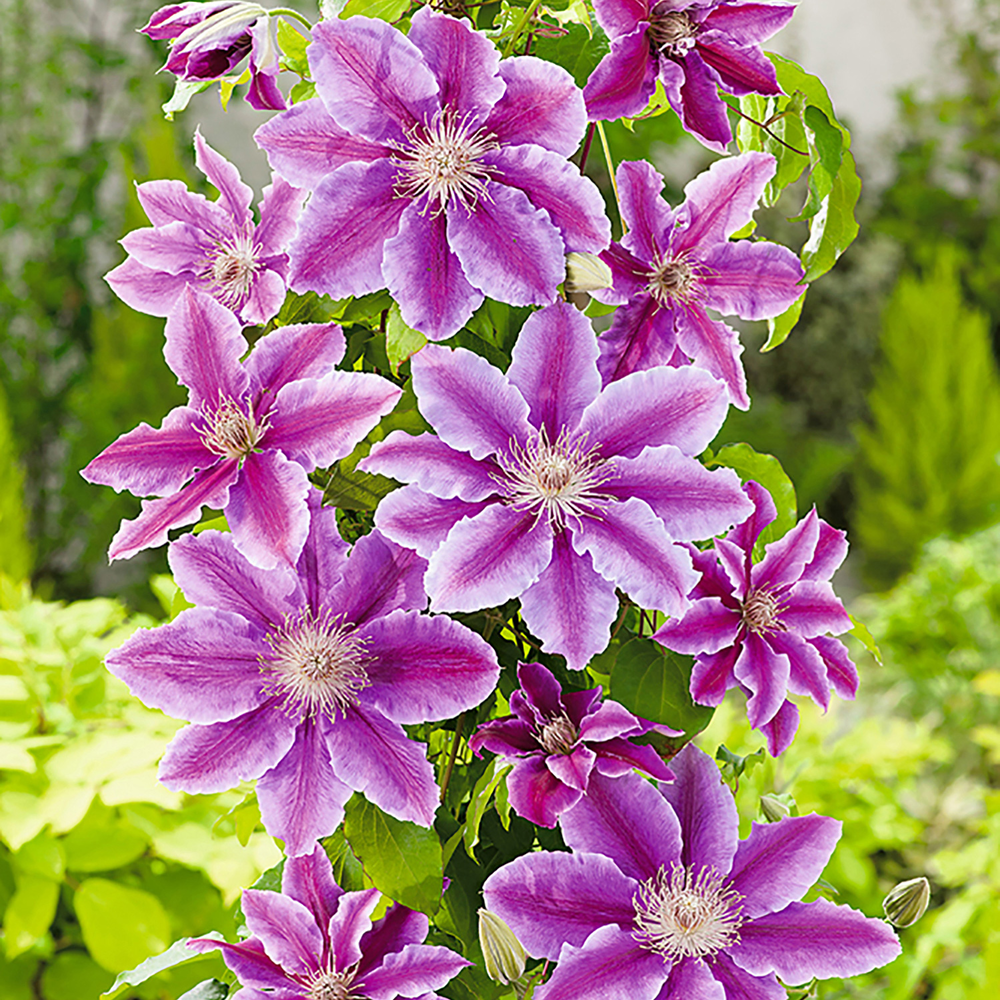
Clematis doctor ruppel landing
Breeding technology:
- In early spring or before the beginning of budding, a healthy branch is cut at an angle of 45 degrees, about 20 cm long, so that 2 growth buds are present on it.
- Leaves are removed or partially cut off.
- Close up in a wet soil mixture, consisting of 2 parts of leaf compost and 1 part of river sand. A film is stretched over the container to create a greenhouse effect.
The principle of rooting of lignified shoots is similar, only they are cut in the fall, pre-treated with Kornevin and kept in a cool shaded room.
By dividing the bush
Sharing clematis is allowed only after they reach 5 years of age. The procedure is indicated if it is necessary to transplant a plant or to rejuvenate a heavily overgrown shrub.
Work is carried out in the fall (preferably for central Russia) or in the spring before the start of sap flow, following the technological description of the process:
- Prepare holes for plots, watered abundantly. It is allowed to add Kornevin to the water.
- Cut the crown of the liana, leaving a stump with 2-3 growth buds. The plant is dug around the perimeter, removed from the ground, washed.
- Using a sharp tool, the rhizome is divided so that roots and several productive shoots are present on each part. If necessary, the injured segments are cut off.
- The plots are soaked in fungicide, planted in prepared holes (the neck is deepened by 10-12 cm).
Layers
To obtain layering in the ground, a recess is made 10 cm deep, to which the lateral shoot is bent and covered with earth. Water and regular maintenance throughout the summer.
In the fall, the rooting process begins, the seedling is separated from the mother bush only the next year.
Diseases and pests
For the prevention of fungal diseases in the spring, clematis is watered with milk of lime, which is made at the rate of 200 g of lime or dolomite flour per 10 liters of liquid. Additionally treated with a solution of urea (25 g per 10 l).
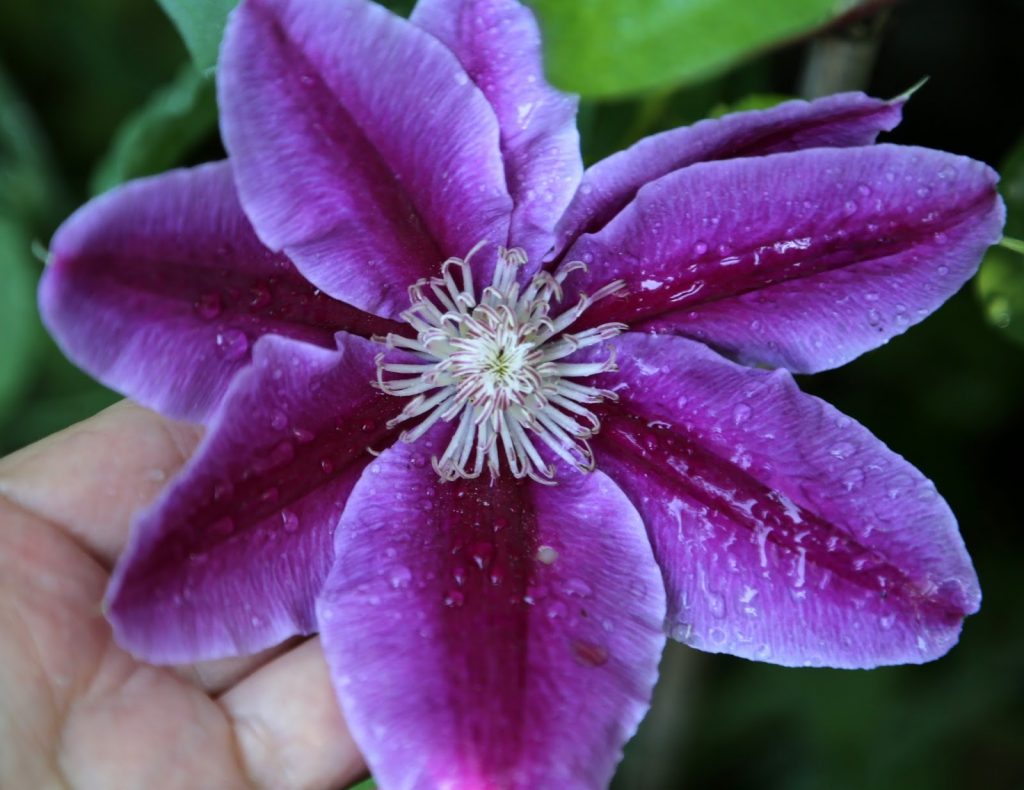
Clematis hybrid doctor ruppel
In the event of symptoms of gray rot, powdery mildew or rust, the affected areas are removed, sprayed with fungicidal preparations. Tricoflor helps to cope with wilt. It is also recommended for prophylactic purposes to be added to the hole when planting a seedling.
In early spring, the vine should be sprayed with a 1% solution of copper sulfate. Aphids are dealt with with soapy water.
Use in landscape design
Dr. Ruppel is used as a vertical element in garden landscaping. Liana-like shrub looks great near fences, buildings, gazebos, old trees. For completeness of the composition, undersized annuals, hostu or cuff are planted from below. A good tandem is obtained with morning glory or a climbing rose.
Reviews by the gardener
If we rely on the opinion of gardeners, then we can conclude that the bush is really unpretentious in care and is resistant to disease. There is also no doubt about the decorative characteristics. However, some are faced with the difficulties of wintering the culture.
In especially harsh regions, even if warmed for the winter, clematis still freezes. Some florists advise to build a more serious shelter, supplementing it with a wooden box.
The rest of the audience, in order to preserve the decorative effect, switched to the 3rd group of trimming. In the latter case, flowering occurs at a relatively late date, but it is abundant.

